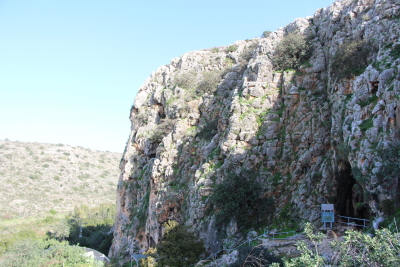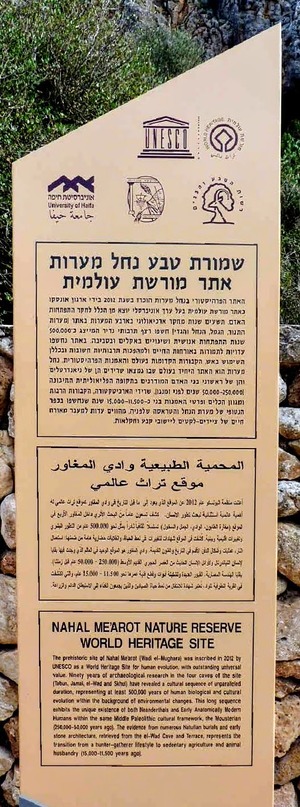Mount Carmel Caves

The Sites of Human Evolution at Mount Carmel: The Nahal Me’arot / Wadi el-Mughara Caves testify to more than 500,000 years of human evolution.
The four caves are situated on a cliff in the Mount Carmel range. The area was inhabited by both Neanderthals and modern humans. Findings such as skeletal material, pits and stone structures have made it possible to create a chronological framework of human evolution from the first appearance of modern humans to the transition from hunter-gathering to agriculture.
Community Perspective: As usual with paleontological sites, there is little to see for the casual visitor. The rock views of the surrounding natural reserve are the most gratifying visuals at the site. Solivagant has put the site into historical perspective.
Map of Mount Carmel Caves
Community Reviews
Ilya Burlak

Nahal Me’arot may represent half a million years of human evolution, but they are a clear contender for the title of one of the least impressive paid-entry sights that I have ever been to. There are three caves that you can see here, although the first two are more overhangs than caves and can be viewed only from a distance behind the barrier. The first diagrams the geological ages of its layers, the second illustrates a prehistoric settlement with a few highly unsophisticated models and props.
The third cave can be entered. It is 70 meters deep, with nothing of a particular exceptional note. At the end of this cave you can see an AV presentation – a dramatization of the prehistoric life that looks like a failed costumed home-video attempt. I watched that for about seven minutes and could not stomach the cheesy show any longer. (On the positive side, there are sensors in the cave, and the presentation started right away when I approached the screen – it would be a lot more maddening if I had to spend time waiting for it to start first).
The rock views of the surrounding natural reserve are the most gratifying visuals at the site. The reserve may provide additional entertainment if you have kids in tow – who knows, they may even enjoy that movie – and want to do some hiking in addition to seeing the caves.
My entire visit in November of 2019 lasted no more than 20 minutes. I allow that coming here with a specialist guide who can provide insight into what you are seeing may be more useful than visiting on your own and reading from a booklet. I was the only caller on an early morning – the girl at the reception was clearly surprised to see someone show up. The caves are located a little bit over an hour from Tel Aviv by car, or half an hour from Haifa.
Read more from Ilya Burlak here.
Stanislaw Warwas

Visited September 2017
For those who have no background of prehistory, these caves can be disappointing. Well, not even caves, because only one of four (Nahal) can be called a cave; the three are rather shelters or holes in the natural cliff façade (the ceilings, first floors of the karst caves collapsed thousand years ago and paradoxically saved remains of our ancestors’ culture). But if you are able to stimulate your imagination and go far back half a million years ago… And if there’s a guide who can explain what you’re looking at… The outstanding value of this site becomes clear and unquestionable. This is the most exiting journey through human (pre)history you can experience, although not many traces are left.
There are many other caves or underground structures on both sides of Wadi El Mughara, and some of them are being excavated. Maybe in the future some other of these caves will be included into the list…
Solivagant

A pleasing aspect of carrying out a thorough trawl through the inscribed and T List sites of Israel and Palestine is that you can make a pretty complete tour along the timeline of human history in the Levant. To do so you need to start at the Carmel Caves where you can “enter” with Lower Paleolithic (from around 200k YBP) and pass through the Acheulian, Muarian, Mousterian (Neanderthal), Aurignacian and, finally, Natufian cultures (c10k YBP) at the borders of Upper Paleolithic/Neolithic – ready to move on to the true Neolithic at Jericho! Despite its coverage of an enormous time period, there isn’t a great deal actually to “see” at this site – just 4 “caves” situated at a cliff face. A reasonably thorough visit should only take about an hour. The caves are situated within the Nahal Me’arot Nature Reserve which seems to be “free entry” (and was packed out with “non-observant” Israelis when we were there on the Shabbat!) but you won’t get inside the “caged” cave area without having paid your 22 NIS entry fee (or have a “pass” as we did). The caves are reached in the following sequence
a. Tabun. The face of this “cave” is is viewed from an observation point at a distance of some 15 metres and I found it to be the most interesting as it possesses a well exposed series of archaeological strata covering around 150k years which are nicely identified and explained via a series of markers (photo) next to an explanatory board. Only here will you get a real feeling for the passage of time across all the cultures which used the site. It was in this cave that Neanderthal remains were found - prompting debate about the nature of their concurrent existence with Homo Sapiens Sapiens.
b. Gamal. A shallow cave which has been used to display a series of slightly pathetic models of “early humans” and some of their foods from the Mousterian period - strictly for the “kids” I think!
c. Nahal. 70 metres deep with a nice exposure of the limestone reef from which the caves were eroded. At the back, an audio-visual dramatization of the humans who lived in the caves is played at fixed times. Again I think this was primarily aimed at kids.
But weren’t 4 caves inscribed? Indeed, but I had to ask at the Visitor Centre where the 4th was as it receives no mention in the flyer they had handed out. This is the Skhul Cave which lies outside the caged area and is reached by walking 200 metres or so up the valley behind the Centre and climbing a short path behind an electricity sub station (it is signed in Hebrew!). This is hardly a cave at all – rather a small overhang but is where perhaps the most significant findings were made in the form of “purposeful burials” (the earliest discovered anywhere in the World to date?) of 7 adults and 3 children, some with shell ornamentation, dating back around 80-120k YBP. A copy of a skeleton, arranged as it was found, has been placed near Nahal Cave (ie inside the “cage”!) but 2 originals are on display at the Rockefeller Museum in Jerusalem. The skeletons exhibit some archaic traits and are the subject of much debate – do they represent Neanderthal hybridization or perhaps the second exodus of man from Africa which is now thought to have taken place through Israel. In any case, although there is nothing to see at the cave itself, it was nice to have seen the location where these remains were discovered, together with the originals in a museum.
Allison Vies
Switzerland/Peru - 08-Jan-13 -
The Carmel caves are an easy WHS to tick off. They are conveniently located close to route 4 and make a nice stopover when travelling between the WHS of Tel Aviv and Haifa. As for all fossil sites, don't expect to see much. There are a few descriptions, a few stone age tools, a film and in one of the 3 visible caves some puppets, recreating the live in the cave. But the landscape is nice and the caves are really easy to reach. You can enter one of them; the others are seen from the outside. About half an hour should do it to visit the site.
Assif
The Carmel caves are the only site where both Homo Sapiens and Neanderthals have been found side by side. Despite its historical significance there is really not much to see for the casual visitor. Access is only in guided tours where you get explained about the history of the digging and can watch a film about how people lived in these caves. The entire tour takes about half an hour. Most interesting findings like bone jewelry and stone utensils are on display in the small museum of prehistory in the nearby city of Haifa (where you can also visit the WHS Bahai Gardens).
Community Rating
- : Can SARICA
- : K2flake
- : Stanislaw Warwas Travelure Xiquinho Silva
- : Tarquinio_Superbo Walter Alexander Lehmann Tamara Ratz Boppare
- : Ralf Regele AndreaTLV Isabellemarais Gary Arndt Argo
- : Solivagant John Smaranda Nan Christravelblog Martina Rúčková
- : Craig Harder Thomas van der Walt Philipp Peterer Philipp Leu Lucio Gorla Assif Sncjob Dennis Nicklaus Tony0001 Bernard Joseph Esposo Guerrero
- : Ivan Rucek
- : Szucs Tamas Wojciech Fedoruk Mikko Ilya Burlak
- : Zoë Sheng Lukasz Palczewski
Site Info
- Full Name
- Sites of Human Evolution at Mount Carmel: The Nahal Me'arot / Wadi el-Mughara Caves
- Unesco ID
- 1393
- Country
- Israel
- Inscribed
- 2012
- Type
- Cultural
- Criteria
-
3 5
- Categories
- Paleontology - Human evolution
- Link
- By ID
Site History
2012 Rejected
For natural criterium 8 (was proposed as a mixed site, went on to be inscribed as a cultural site)
2012 Revision
Previously on T List as Pre-historic Sites: Ubadiyya, Sha'ar Hagolan, Mount Carmel (mixed site, 2000)
2012 Inscribed
Site Links
Unesco Website
Official Website
In the News
Connections
The site has 15 connections
Ecology
History
Human Activity
Individual People
Timeline
Trivia
WHS on Other Lists
World Heritage Process
Visitors
110 Community Members have visited.
